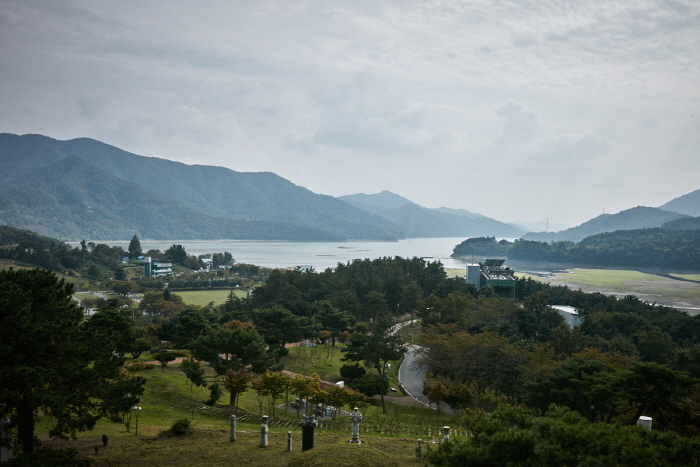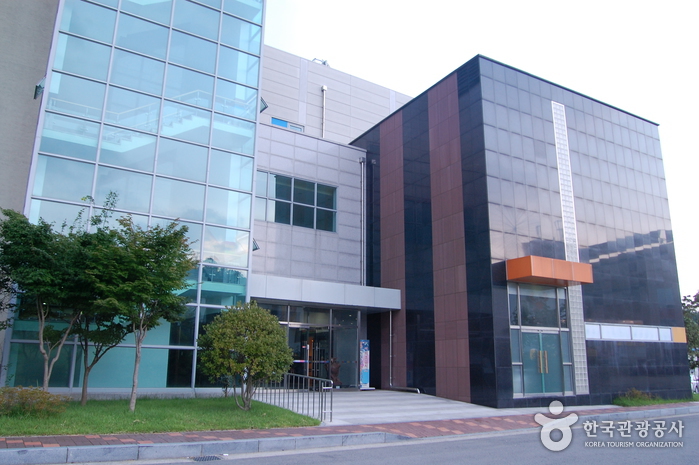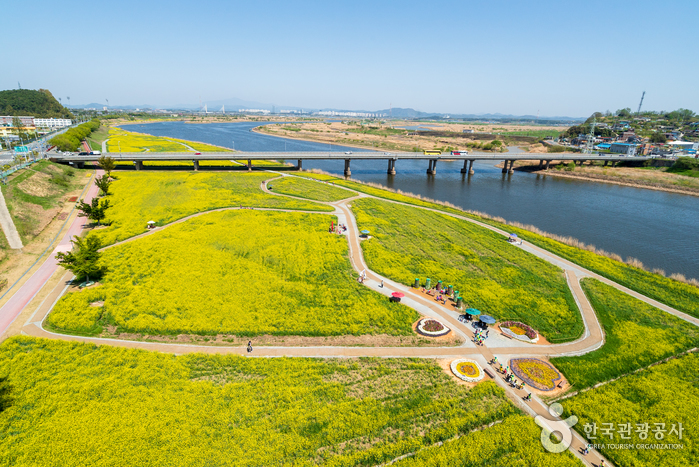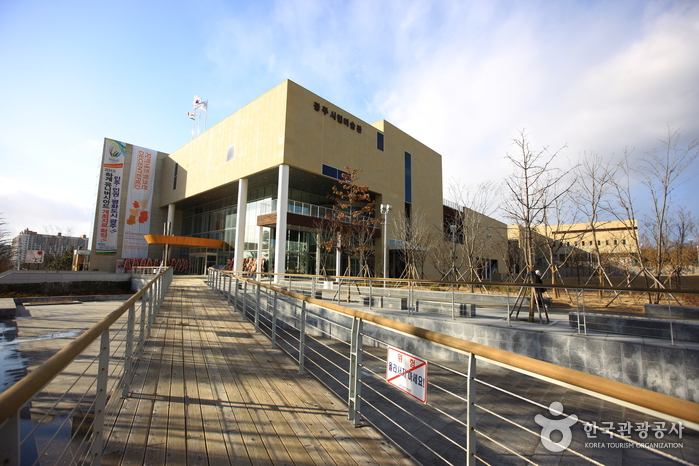Jangseongho Tourist Area (장성호관광지)
15.1Km 2025-01-08
591-8, Baegyang-ro, Jangseong-gun, Jeollanam-do
+82-61-392-7248
Jangseongho Tourist Area is located south of Naejangsan National Park, in Jangseong, known as the hometown of Hong Gil-dong, a Korean Robin Hood. The lake was made by the damming of Hwangnyonggang River, and holds up to 89.7 million tons of water, filled with many freshwater fish species. In addition, the walking path along the 603-meter-long embankment attracts many tourists with beautiful views of the mountains and lake. Cruise ferries and motorboats also cross the lake. Nearby attractions include Ibamsan and Baegamsan Mountains, Namchanggyegok Valley, Baegyangsa and Naejangsa Temples, Gosanseowon Confucian Academy, Bangjangsan Recreational Forest, and more.
Olive Young - Gwangju Hanam Columbus Branch [Tax Refund Shop] (올리브영 광주하남콜럼버스)
15.1Km 2024-04-18
Store #103, #104, 38-6, Saam-ro 216beon-gil, Gwangsan-gu, Gwangju
-
Seok Jeong Hill C.C. (호텔석정힐)
15.2Km 2024-12-24
192 , Seokjeong 2-ro, Gochang-gun, Jeonbuk-do
+82-63-563-7711
Seokjeong Resort is a 5 minutes drive from the Seokjeong Hill Country Club golf course in Gochang, Jeonbuk-do. It is mainly frequented by golf course users, but general travelers are also welcome. The hotel provides clean, comfortable rooms and has a seminar room for group events and business meetings.
E-Mart - Gwangsan Branch [Tax Refund Shop] (이마트 광산)
15.4Km 2024-04-22
172, Saam-ro, Gwangsan-gu, Gwangju
-
Namdo Folk Food Exhibition Room & Honam Cultural Material Pavilion (남도향토음식박물관·호남문화자료전시관)
15.4Km 2021-11-27
477, Seoljuk-ro, Buk-gu, Gwangju
+82-62-410-6642
Located in Gwangju, the Namdo Folk Food Exhibition Room was established to preserve and promote the local foods of the Namdo region. The museum has a museum shop, both permanent exhibitions and special planned exhibitions, and a studio where visitors can watch a variety of video content related to the local foods. In the Honam Cultural Material Pavilion, literature, clothing, and artwork from the region are on display.
The museum building was designed to resemble both the long, rectangular presses used to make patterned rice cakes and the Ipseokdae Rock of Mudeungsan Mountain, a symbol of Gwangju. Even the colors of the building’s walls hold special significance. The obangsaek (five colors; blue, white, red, black, and yellow) symbolize the cardinal directions, the seasons, the major organs in the body, different tastes, feelings, and philosophy.
Gwangju National Museum (국립광주박물관)
15.5Km 2023-11-28
110 Haseo-ro, Buk-gu, Gwangju
+82-62-570-7000
Gwangju National Museum, opened on December 6, 1978, was established to promote the development of cultural arts and to foster patriotism. Gwangju National Museum’s goal is to conserve cultural values through the collection and preservation of historical and valuable artifacts found in the Gwangju and Jeollanam-do regions as well as make contributions to the community through continuous research, exhibition, and education. With over 130,000 artifacts as well as various educational and experience programs, the museum aims to provide an enjoyable cultural center for visitors.
Donggok Museum of Art (동곡미술관)
15.5Km 2024-12-17
37 Eodeung-daero 529beon-gil, Gwangsan-gu, Gwangju
Donggok Museum of Art, opened in December 2020, a two-story building has exhibition halls, educational rooms, a sculpture park and more. There are rest areas to relax after enjoying arts, as well as spaces for visitors to find their creativity.
Yeongsangang River (영산강)
15.9Km 2020-05-19
Gaedongsingi-gil, Damyang-gun, Jeollanam-do
+82-61-380-2820
Yeongsangang River (136 kilometers) is the shortest of the four major rivers in Korea. The river starts from Yongchubong Peak (560m) located in Yong-myeon in Damyang, Jeollanam-do. It runs through Damyang, Gwangju, Naju, and Yeongam and eventually flows into the Yellow Sea in Mokpo through the estuary bank.
The river also faces some environmental challenges, including extreme weather events that cause flooding, leading to ecosystem loss and habitat degradation. In December 1981, a dam was built and the damage was significantly reduced. The government has also introduced the Four Major Rivers Restoration Project in 2009 with the objective of restoring the rivers while achieving regional development. Under this project, a significant amount of budget was allocated for resolving problems plaguing the Yeongsangang River.
Gochang Moyang Fortress Festival (고창모양성제)
16.0Km 2024-07-17
Eumnae-ri, Gochang-eup, Gochang-gun, Jeonbuk-do
+82-63-560-2949
Gochang Moyang Fortress Festival has been held since 1973 to inspire admiration for the construction of the walled town, develop local culture, and encourage love and pride for Gochang residents. Main events include a celebration and memorial ceremony, with additional events ranging from a pansori performance and farming music to folk games and archery. Many people participate in the Dapseongnori event, where participants carry a rock on top of their heads and walk around the fortress three times. Doing this is said to cure all illnesses, grant a long and healthy life, and allow one into heaven.
Gwangju Museum of Art (광주시립미술관)
16.1Km 2022-09-02
52, Haseo-ro, Buk-gu, Gwangju
+82-62-613-7100
The Gwangju Museum of Art was founded on August 1, 1992, to promote local artists. In 1996, it served as the venue for the Gwangju Biennale. The museum holds over 560 works, including those from Heo Baekryeon, Oh Jiho, Yang Su-ah, and Im Jik-sun, all local artists. In addition to the permanent exhibitions, the museum also has special planned exhibitions and other cultural programs.

![Olive Young - Gwangju Hanam Columbus Branch [Tax Refund Shop] (올리브영 광주하남콜럼버스)](http://tong.visitkorea.or.kr/cms/resource/79/2886979_image2_1.jpg)
![E-Mart - Gwangsan Branch [Tax Refund Shop] (이마트 광산)](http://tong.visitkorea.or.kr/cms/resource/86/2886986_image2_1.jpg)




 English
English
 한국어
한국어 日本語
日本語 中文(简体)
中文(简体) Deutsch
Deutsch Français
Français Español
Español Русский
Русский